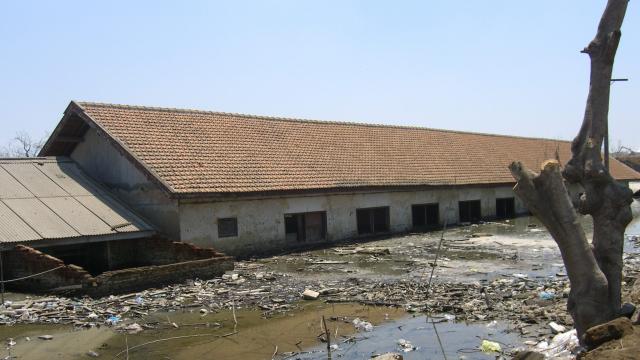The largest mud volcano eruption has been raging in Indonesia since May 29, 2006. At its peak, 180,000 cubic meters of mud flowed daily from a site near a heavily populated region of Java, Indonesia — enough mud to completely fill the Empire State Building every six days. Almost 60,000 villagers have fled since then, and it’s still spewing 80,000 cubic meters per day.
A school flooded by the mud (Image: Hugh e82/Wikimedia Commons)
Plenty of researchers have been studying the site since it began spewing, and scientists as well as oil companies have debated what set off the initial chain reaction. But the shape and nature of the underground mud source has been uncertain. A team from Europe and Indonesia is reporting that, using “ambient noise tomography,” they have determined how the underground mud-supplying complex actually looks — what’s actually driving all of this flow. They’re making a map of the leak’s source plumbing.
The site, called the Sidoarjo mud flow or Lusi for short, is a “The complete image revealed that a long tube connects the neighbouring volcanic complex to the Lusi mudflow deep underground. They surmised that fluid moves towards Lusi, where it mixes with dirt and rocks to provide the heat and material powering the mudflow. They published their results in the Journal of Geophysical Research: Solid Earth.
That could be where the mud is from, but what kicked off the disaster has been a topic of debate. Perhaps a blowout following drilling from the Lapindo Branta oil and gas company piercing an underground aquifer set the whole system off, posits one paper. This was further supported by a 2015 paper.
Or maybe an earthquake could have been what kicked off the eruption — a magnitude 6.3 quake struck the area two days before the mudflow started, according to an American Geophysical Union release. Still, the Indonesian government decided in 2007 that Lapindo should compensate the victims in the area, according to the NY Times.
One researcher not involved with the study, Stephen Miller from the University of Neuchâtel in Switzerland, told the AGU that one thing is for sure: It’s unlikely the mud will stop anytime soon.
[JGR: Solid Earth via AGU]
